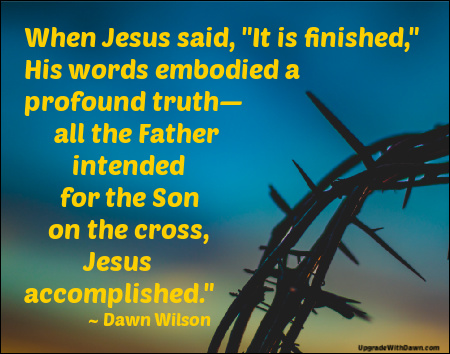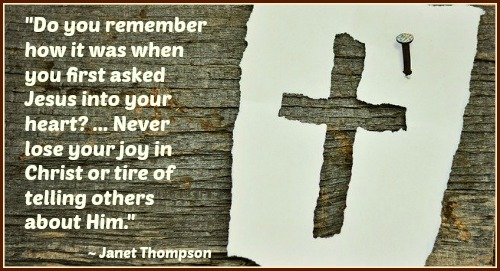What Was 'Finished' at the Cross?
As I pondered the meaning of Good Friday, a phrase stuck in my mind—“It is finished!”
Jesus said those words—found only in the Gospel of John (19:30)—as He hung, battered and bloody, on the cross.
When I was younger, I thought those words meant, “I’m finished … I’m dying.” But Jesus didn’t say, “I’m finished.” He said, “IT is finished.”
What was IT? What was finished?
I thought of at least five things that were finished.
1. The sufferings of Jesus on earth were finally over.
In His obedience to the Father’s will (John 5:30; 6:38), Jesus suffered on the cross. It brought not only terrible pain, but also “separation” from God for our sake (Matthew 27:46). The holy Father could not look on His Son as He bore our sins.
But Jesus’ pain was finally over.
His “chastisement” on the cross brought us peace (Isaiah 53:5). The Father “crushed” Jesus for our sake (Isaiah 53:10-11).
Throughout His ministry He sought and taught the lost (Luke 19:10). He lived a sinless, righteous life (1 Peter 2:22). And Jesus said He had “finished the work” God gave Him to do on earth (John 17:4).
Jesus left no doubt why He hung on that Roman cross, and when He cried out, it was a final shout of victory.
Done. Accomplished. No unfinished business.
2. The debt of sin was cancelled for those who believe.
There is no more sacrifice for sin (Hebrews 10:1-18). When Jesus said, tetelestai—“It is finished”—He signaled to the Jews the end of temple sacrifices, because His work on the cross was the ultimate fulfillment of all the Jewish sacrificial system foreshadowed (Hebrews 9:12, 26).
Tetelestai is an accounting term. It means “paid in FULL.” It’s a Greek word, perfect tense, that speaks of an action completed in the past, but with results that continue into the present and future.
Jesus died for us "while we were still sinners" (Romans 5:8-9). The debt we owed God because of our sinful rebellion against Him (Romans 8:7)—rebellion that rightfully incurred His wrath—was wiped away.
Completely.
Forever.
Because God is holy and just, He had to respond to sin with punishment. Yet He also loves sinners and desired reconciliation.
It’s been said that the cross of Christ was the place where God's wrath and love met. When Jesus died for us, it saved us from the wrath of God.
Jon Bloom wrote,
“The death of Christ was real, and it was really terrible. He was an object of wrath.”
Jesus knew His mission (Luke 9:22; John 12:27), and He suffered the Father’s wrath—for us. At the cross, God could redeem mankind without compromising His character. And His mercy and grace were lavished upon us.
We must never forget all that Jesus suffered. And why.
2. The bondage to guilt was broken.
Our Lord’s death was the payment for our forgiveness. His righteous life and substitutionary death satisfied the Father.
We don’t need to beat ourselves up over past sins. We can come to God and confess our sins—admit them to God—but know they are “under the blood.”
They are forgiven! Totally! Never to be brought up again.
The Father looks at the sacrifice His Son made for us, and He is satisfied.
I love these words from the Getty song, “In Christ Alone”—
"Till on that cross as Jesus died, The wrath of God was satisfied;
For ev’ry sin on Him was laid—Here in the death of Christ I live.”
We may feel our sins are too great, but the truth is, no sin is too great for His mercy. Feelings of shame and guilt may try to creep back into our mind to condemn us, but we are forgiven. We are no longer condemned (Romans 8:1).
(Friend—If you struggle with joy-robbing guilty feelings, look in the mirror and say, “Jesus died for my sins and I am forgiven. My guilt is ‘finished’!” Repeat it until that great truth sinks in.)
3. The first-coming Messianic prophecies were fulfilled.
It’s said there are more than 300 specific biblical prophecies that pointed to the coming of the Messiah, the Anointed One.
Many of these prophecies were fulfilled in Jesus—a great number of them on the cross. (See "How Many Prophecies Did Jesus Fulfill?")
4. Satan’s power was broken.
Genesis 3:15 prophesied the coming of the “seed” who would crush the serpent’s head. On the cross, the Suffering Servant of Isaiah 53 dealt a death blow to Satan’s power.
Jesus came to “destroy the works of the devil” (1 John 3:8).
No longer would mankind have to endure the “flaming arrows of the evil one” (Ephesians 6:16). Satan knows he is on borrowed time, and he tries to intimidate the saints.
5. Death no longer reigned for the believer!
The Old Testament believers looked forward to the cross; we look back to it.
Jesus came to draw all people to Himself (John 12:32)—a reality made possible at the cross. He died to take away the sin of the world (John 1:29), and become the “propitiation” (atonement) for our sins (1 John 2:2).
His finished work on the cross was the beginning of new life (2 Corinthians 5:17) for all who were “dead in trespasses and sins" ... now made “alive in Christ” (Ephesians 2:1,5).
His resurrection is our guarantee—Jesus told His followers, "because I live, you also will live" (John 14:19).
Praise God, death no longer reigns for the believer.
Christ-followers pass from the grave to glory in the presence of their Savior! Death has no more "sting" (1 Corinthians 15:55-57). We rise victorious from the grave!
When Jesus said, "It is finished," His words embodied a profound truth—all the Father intended for the Son on the cross, Jesus accomplished.
"It Is Finished!"
Our Lord’s words final words are precious.
They are words to treasure—a statement that continues to have great power and purpose for all who believe.
What does "It is finished" mean for you today? Can you take a moment to thank Jesus that He left nothing undone at the cross?
Dawn Wilson, founder and President of Heart Choices Today, is a speaker and author,  and the creator the blog, Upgrade with Dawn. She is a contracted researcher/reviewer for women's teacher and revivalist, Nancy DeMoss Wolgemuth, at Revive Our Hearts, a blogger at TrueWoman.com, writes wiki-type posts at Christianity.com, and is a regular columnist at Crosswalk.com. She and her husband Bob live in sunny Southern California, and Dawn has traveled with Him in Pacesetter Global Outreach. They have two grown, married sons, three granddaughters and a rascally maltipoo, Roscoe.
and the creator the blog, Upgrade with Dawn. She is a contracted researcher/reviewer for women's teacher and revivalist, Nancy DeMoss Wolgemuth, at Revive Our Hearts, a blogger at TrueWoman.com, writes wiki-type posts at Christianity.com, and is a regular columnist at Crosswalk.com. She and her husband Bob live in sunny Southern California, and Dawn has traveled with Him in Pacesetter Global Outreach. They have two grown, married sons, three granddaughters and a rascally maltipoo, Roscoe.
Graphic adapted, courtesy of Forgiven Photography at Lightstock.
 Post a Comment → Posted on
Post a Comment → Posted on  Friday, April 2, 2021 at 9:25PM
Friday, April 2, 2021 at 9:25PM  Crucifixion,
Crucifixion,  Dawn Wilson,
Dawn Wilson,  Finished Work of Christ,
Finished Work of Christ,  Good Friday,
Good Friday,  It Is Finished,
It Is Finished,  Jesus on the Cross,
Jesus on the Cross,  Upgrade with Dawn Upgrade Your Life
Upgrade with Dawn Upgrade Your Life  Easter,
Easter,  The Cross
The Cross 






